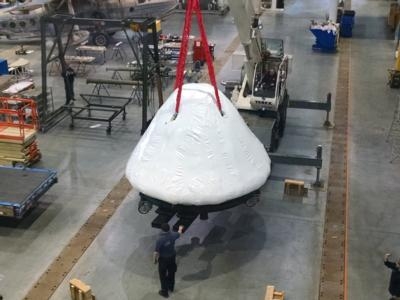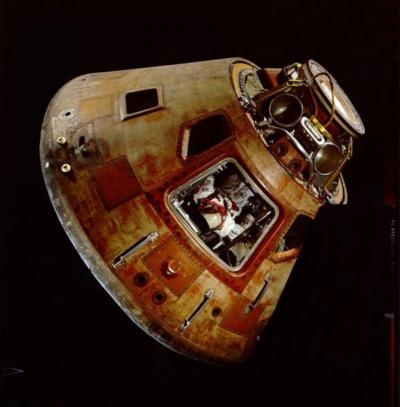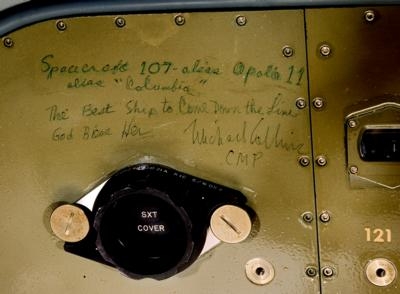Historic Spacecraft Now On Display At The Air And Space Museum's Udvar-Hazy Center
The Apollo 11 Command Module, Columbia, which carried Neil Armstrong, Buzz Aldrin, and Michael Collins on their historic trip to the Moon, has been moved to the Steven F. Udvar-Hazy Center in Chantilly, Virginia. To many of those involved in the project, the move seemed to have miraculously happened overnight. In truth, the move took a team of experts and months of meticulous planning to pull off.

“This is something that’s unlike anything, at least for me, that I’ve ever moved,” said Anthony Wallace, a supervisory museum specialist in the Museum’s collections processing unit. Wallace explained that the spacecraft was not as complicated to move as some of the Museum’s aircraft, but the historical significance of the object heightened everyone’s awareness.
Wallace and conservator Lisa Young, along with a team of dedicated collections staff, began discussing the move as early as the summer. How would they lift the module? How would they transport the module? And how would they protect the module in transit? The team attempted to think of every possible situation they might find themselves in and planned a response.
“It really is a team effort between departments that all have different knowledge,” Young said. “We all have different expertise that have to come together to make this happen.”
Columbia has been on display in Washington, DC since the Museum opened in 1976. Before the team applied any packing material to the command module a good cleaning was in order. “I didn’t want the wrapping materials to abrade (scrape or wear away) anything on the exterior,” Young said.
The windows were then padded with Ethafoam, and Tyvek was carefully wrapped around the module to prevent any additional layers from touching the object’s surface. An upholstery grade foam batting was then added to provide cushioning as well as insulation from weather. “If there were changes in temperature there wouldn’t be a drop at the surface of the object,” Young said.
Finally, a shrink-wrap material was added in the same pattern of the Tyvek underneath. The team made sure that the seams on the shrink wrap were placed exactly so to prevent wind from snagging it in transit.
The official move took place in one night. The move took a total of 10 people approximately six hours to complete and a list of logistics that would overwhelm the best of us.

The module was lifted by a rented crane from four known structural points at the top—these were the same points that the escape launch tower attached to during launch. Permits were obtained ahead of time to close down part of Independence Avenue to make room for the work. A specially constructed stand attached to the bottom of the module moved with it. The stand helped protect the delicate heat shield during the move.
Wallace said most objects fit within the Museum’s enclosed truck, but Columbia did not. Because the command module would be exposed during transit, monitoring the weather was key. Drastic drops in temperature, rain, snow, wind, or even chemically treated roads would have posed a problem.
The team got lucky, and although the temperature dropped down to 29 degrees, it was perfect weather for moving a spacecraft. The drive from the Museum in Washington, DC, to Chantilly, Virginia, took approximately an hour with escorts from the National Park Service Police. The team wrapped up the move around 11:45 pm.
Young noted that the command module was tied up and packed so well that “it didn’t shift a centimeter” during transit.
The module, which can now be seen in the Mary Baker Engen Restoration Hangar, will remain wrapped in its packing material for another few days while the object acclimates to its new environment—a process that’s common for all objects, Young explained. Then it will undergo extensive documentation and conservation treatment.
“The condition is sensitive, it’s reaching 50 years old, it’s been in the ocean,” Young said.

Of particular concern for Young is the paint in the interior of the module. It’s been contaminated by chloride from its time in the ocean—following a successful mission to the Moon, Columbia splashed down in the Pacific Ocean on July 24, 1969.
She also worries about the heat shield, which is dry and flaking, as well as oxidation of metals on horizontal surfaces.
The team plans to use high-resolution photography taken from an earlier 3D scan, technical and engineering documents, and materials research to inform their treatment plan. Multi-spectral imaging of signatures found inside the command module is also planned. The imaging process will provide the team with 3D images of the inks used on the surface and help them to monitor the condition of the signatures over time.
(Images provided with Smithsonian Institute news release)
 Unfortunate... ANN/SportPlane Resource Guide Adds To Cautionary Advisories
Unfortunate... ANN/SportPlane Resource Guide Adds To Cautionary Advisories ANN FAQ: Turn On Post Notifications
ANN FAQ: Turn On Post Notifications ANN's Daily Aero-Term (04.29.24): Visual Approach Slope Indicator (VASI)
ANN's Daily Aero-Term (04.29.24): Visual Approach Slope Indicator (VASI) ANN's Daily Aero-Term (04.28.24): Airport Marking Aids
ANN's Daily Aero-Term (04.28.24): Airport Marking Aids ANN's Daily Aero-Linx (04.28.24)
ANN's Daily Aero-Linx (04.28.24)





